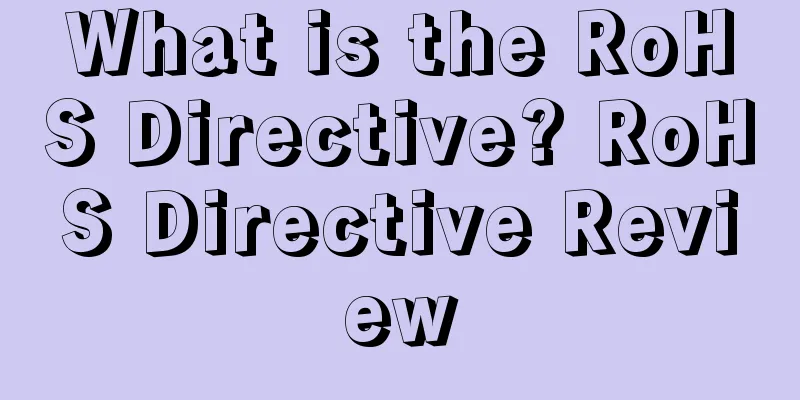What is the RoHS Directive? RoHS Directive Review

|
RoHS is a mandatory standard established by EU legislation. Its full name is "Directive on the restriction of the use of certain hazardous substances in electrical and electronic equipment". About RoHS Directive The RoHS directive was officially implemented on July 1, 2006. It is mainly used to regulate the material and process standards of electronic and electrical products to make them more beneficial to human health and environmental protection. The purpose of this standard is to eliminate six substances in electrical and electronic products, including lead, mercury, cadmium, hexavalent chromium, polybrominated biphenyls and polybrominated diphenyl ethers (Note: the correct Chinese name of PBDE refers to polybrominated diphenyl ethers, and polybrominated diphenyl ethers is an incorrect term), and it specifically stipulates that the lead content cannot exceed 0.1%. Applicable countries United Kingdom, 26 EU member states: France, Germany, Italy, Netherlands, Belgium, Luxembourg, Denmark, Ireland, Greece, Spain, Portugal, Austria, Sweden, Finland, Cyprus, Hungary, Czech Republic, Estonia, Latvia, Lithuania, Malta, Poland, Slovakia, Slovenia, Bulgaria, Romania. Applicable Products The RoHS directive controls product types, covering the electronic and electrical products listed in the catalog below AC1000V and DC1500V: 1. Large household appliances: refrigerators, washing machines, microwave ovens, air conditioners, etc.; 2. Small household appliances: vacuum cleaners, electric irons, hair dryers, ovens, clocks, etc.; 3. IT and communication equipment: computers, fax machines, telephones, mobile phones, etc.; 4. Civilian devices: radios, televisions, video recorders, musical instruments, etc.; 5. Lighting appliances: fluorescent lamps other than household lighting, lighting control devices; 6. Power tools: electric drill, lathe, welding, sprayer, etc.; 7. Toys/entertainment and sports equipment: electric cars, video game consoles, automatic gambling machines, etc.; 8. Medical equipment: radiotherapy equipment, electrocardiogram tester, analytical instruments, etc.; 9. Monitoring/control devices: smoke detectors, thermostats, factory monitoring and control machines, etc.; 10. Vending machines. It not only includes the whole machine product, but also includes the parts, raw materials and packaging used to produce the whole machine, and is related to the entire production chain. Certification Process 1. Fill in the RoHS test application form and download it from the RoHS Certification Center website. 2. Quotation settlement. After submitting the application, the customer sends the sample (or express delivery) to the testing agency. The testing agency will reasonably split the sample as required and feedback the product split quantity and testing fee to the customer. After the customer agrees, the testing fee will be deposited into the designated account (cash payment is also possible). 3. After the payment is received, the test will be arranged immediately. Generally, the test will be completed within one week. 4. Reports can be issued by express delivery, fax, email or collected in person by the submitter. Certification bodies Any third-party notarization laboratory with the corresponding qualifications and capabilities can provide similar services to enterprises. How to Test In fact, RoHS certification is not that mysterious. It is similar to the CE certification, FCC certification and other certifications that people are familiar with. As long as a third-party notarized laboratory has the corresponding qualifications and capabilities, it can provide similar services to enterprises. It is nothing more than sending the relevant products to a professional laboratory for testing and analysis. The six harmful substances such as lead, cadmium, mercury, hexavalent chromium, polybrominated biphenyls (PBB), and polybrominated diphenyl ethers (PBDE) are tested to see whether they comply with the requirements of the RoHS Directive. If they do, a RoHS compliance report and certificate can be obtained. If not, other products that meet the requirements must be found as substitutes. Purpose The RoHS Directive is mainly used to regulate the materials and process standards of electronic and electrical products to make them more beneficial to human health and environmental protection. significance If your products are not RoHS certified, it will cause immeasurable damage to the manufacturers. Your products will then be ignored and you will lose the market. If your products are lucky enough to enter the other party's market, once they are discovered, you will be subject to high fines or even criminal detention, which may lead to the closure of the entire enterprise. develop On June 4, 2015, the Official Journal of the European Union (OJ) published the RoHS2.0 revised Directive (EU) 2015/863, which officially included DEHP, BBP, DBP and DIBP in the list of restricted substances in Appendix II. |
>>: What is Revfluence? Revfluence Review
Recommend
What is Little Bee Digital Marketing? Little Bee Digital Marketing Review
Little Bee Digital Marketing is a foreign trade ma...
What is K-Meta? K-Meta Review
K-Meta is a free keyword planning tool with the Un...
What is Grofers? Grofers Review
Grofers is India's largest low-cost online sup...
Breaking news! A large number of Amazon sellers have been scanned by brand associations!
During peak seasons, Amazon seems to review accoun...
Starting today! Amazon uses AI voice technology to provide brand services for enterprises
A brand is a fictional person, and like a person i...
Steps to promote new products on Amazon with advertising without review
Many Amazon sellers use evaluation and off-site me...
What is Twitch? Twitch Review
Twitch is a real-time mainstream streaming video p...
Social e-commerce sales in the United States will reach 80 billion US dollars in 2025!
Social commerce is considered one of the most prom...
DHL's freight rates will increase by 7.9% in 2023, exceeding UPS and FedEx!
It is learned that DHL, the international express ...
So useful! Amazon's free "translation service"
text Amazon’s “Translation Service” is a feature ...
What is Deliveree? Deliveree Review
Deliveree is a comprehensive logistics service com...
What is the Amazon Early Review Program? What are the requirements and benefits?
1. What is the Early Reviewer Program? The Early R...
Under the double blow of riots and epidemic, are sellers’ sales still good?
It is really difficult for Amazon sellers this ye...
Amazon's inventory dropped sharply, how to improve IPI!
Amazon sellers' inventory plummets This year ...
Are many Amazon warehouses closed? Beware of warehousing time limits and frequent infringements
Due to the recent extremely severe weather in the ...









